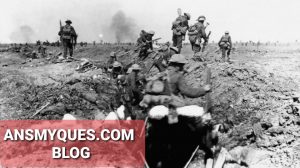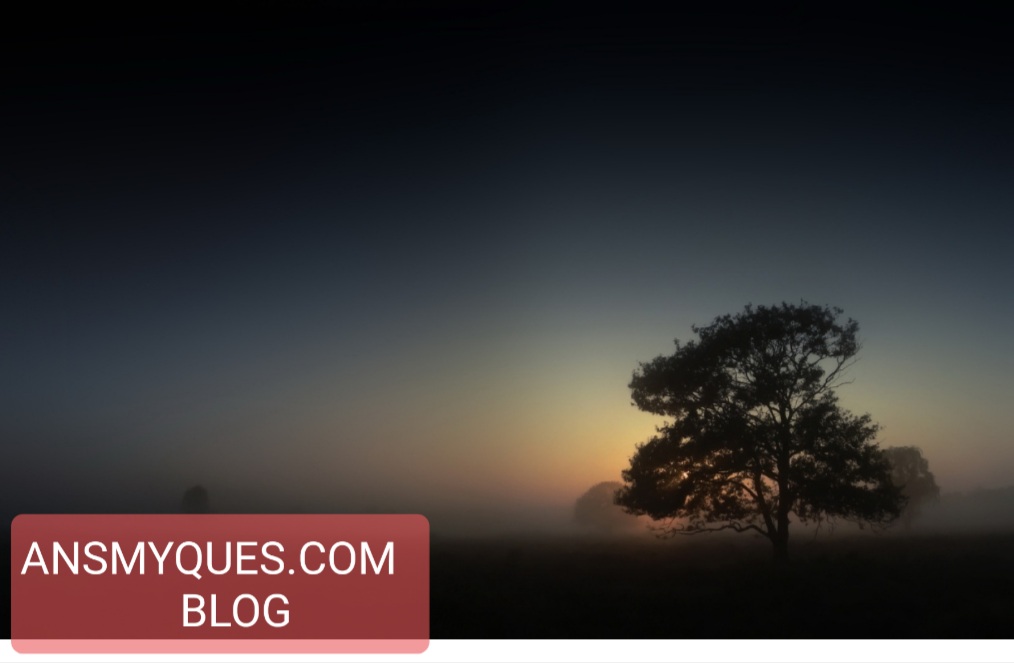ANTHEM FOR A DOOM YOUTH BY WILFRED OWEN, BACKGROUND, SETTING, SUMMARY AND FIGURES OF SPEECH

Anthem for a Doomed Youth
by Wilfred Owen
What passing-bells for these who die as cattle?
–Only the monstrous anger of the guns.
Only the stuttering rifles’ rapid rattle
Can patter out their hasty orisons.
No mockeries for them from prayers or bells,
Nor any voice of mourning save the choirs,-
The shrill, demented choirs of wailing shells;
And bugles calling for them from sad shires.
What candles may be held to speed them all?
Not in the hands of boys, but in their eyes
Shall shine the holy glimmers of goodbyes.
The pallor of girls’ brows shall be their pall;
Their flowers the tenderness of silent minds,
And each slow dusk a drawing-down of blinds.
About the poet
“Anthem for Doomed Youth” was written by British poet Wilfred Owen in 1917, while Owen was in the hospital recovering from injuries and trauma resulting from his military service during World War I. The poem laments the loss of young life in war and describes the sensory horrors of combat. It takes particular issue with the official pomp and ceremony that surrounds war (gestured to by the word “Anthem” in the title), arguing that church bells, prayers, and choirs are inadequate tributes to the realities of war. It is perhaps Owen’s second most famous poem, after “Dulce et Decorum Est.”
Summary of “Anthem for Doomed Youth”
What church bells will ring for the young men slaughtered like farm animals? Instead, these young men just hear the fearsome rage of firing guns. The only prayers they get are the quick and jarring rhythms of rifle fire. These men will have no inappropriate rituals in their names, whether prayers or bell-ringing. No voice will mourn them, except the choirs—the high-pitched and hellish noises of falling artillery. Bugles will call for the young men from sad hometowns and villages.
What candles can be lit to help the dying soldiers in their passage from life to death? Instead of young boys holding these faint lights, the soldiers’ eyes will show the fading light of life as they say their goodbyes to the world. Instead of drapes over their coffins, the soldiers will be remembered by the grief-stricken faces of women and girls. Instead of flowers, perhaps the dead will be honored by peace and diplomacy—by more patience in the world. The end of every day will also be a kind of ritual, as those who live on after the war draw down their window blinds.
Anthem for Doomed Youth’ opens, as do many of Owen’s poems, with a note of righteous anger: what passing-bells for those who die as cattle? The use of the word ‘cattle’ in the opening line sets the tone and the mood for the rest of it – it dehumanizes the soldiers much in the same way
that Owen sees the war dehumanizing the soldiers, bringing up imagery of violence and unnecessary slaughter. Owen made no secret that he was a great critic of the war; his criticism of pro-war poets has been immortalized in poems such as Dulce et Decorum Est, and in letters where Wilfred Owen wrote home. In ‘Anthem for Doomed Youth,’ Owen makes no secret of the fact that he believes the war is a horrific waste of human life.
The first stanza of ‘Anthem for Doomed Youth’ continues in the pattern of a pitched battle, as though it were being written during the Pushover the trenches. Owen notes the ‘monstrous anger’ of the guns, the ‘stuttering rifles’, and the ‘shrill, demented choirs of wailing shells’. It’s a horrible world that Owen creates in those few lines, bringing forward the idea of complete chaos and madness, of an almost animalistic loss of control – but in the same paragraph, he also points out the near-reluctance of the soldiers fighting. At this point, a great deal of the British Army had lost faith in the war as a noble cause and was only fighting out of fear of court-martial, therefore the rifles stutter their ‘hasty orisons’. Orisons are a type of prayer, which
further points out Owen’s lack of faith – he believes that war has overshadowed faith, that it has taken the place of belief. As he says in another poem, ‘we only know war lasts, rain soaks, and clouds sag stormy’.
Ironically, the use of onomatopoeia for the guns and the shells humanizes war far more than its counterparts. War seems a living being when reading this poem; much more so than the soldiers, or the mourners in the second stanza, and the words used – ‘monstrous anger’, ‘stuttering’, ‘shrill demented choirs’ – bring forward the image of war as not only human, but alive, a great monster chewing up everything in its path, including the soldiers that poured out their blood into shell holes. The quiet nature of the second stanza, and the use of softened imagery, brings out, in sharp relief, the differences between war and normal life, which has ceased to be normal at all.
In the second stanza, Owen moves away from the war to speak about the people who have been affected by it: the civilians who mourn their lost brothers, fathers, grandfathers, and uncles, the ones who wait for them to come home and wind up disappointed and miserable when they don’t. The acute loss of life that Owen witnessed in the war is made all the more poignant and heartbreaking in the second stanza, which, compared to the first, seems almost unnaturally still. He speaks about the futility of mourning the dead who have been lost so carelessly, and by making the mourners youthful, he draws further attention to the youthfulness of the soldiers themselves.
Analysis of Anthem for a doom Youth
As the First World War raged on to its completion, Wilfred Owen, the poem, spent the final days of the war incarcerated in Craiglockhart, suffering from an acute case of shellshock and trying to write through the trauma using poetry.
It marked a turning point in his career. Working with Siegfried Sassoon (read Sassoon’s poetry here), Wilfred Owen produced the majority of his writing while convalescing at Craiglockhart, and the poems that he wrote there remain among the most poignant of his pieces. ‘Anthem for Doomed Youth’ was written from September to October 1917.
Anthem for Doomed Youth Wilfred Owen What passing-bells for these who die as cattle? Only the monstrous anger of the guns. Only the stuttering rifles’ rapid rattle Can patter out their hasty orisons. No mockeries now for them; no prayers nor bells; Nor any voice of mourning save the choirs, The shrill, demented choirs of wailing shells; And bugles calling for them from sad shires. What candles may be held to speed them all? Not in the hands of boys, but in their eyes Shall shine the holy glimmers of good-byes. The pallor of girls’ brows shall be their pall; Their flowers the tenderness of patient minds, And each slow dusk a drawing-down of blinds.
POINT TO NOTE IN ANTHEM FOR A DOOM YOUTH
Written in sonnet form, ‘Anthem for Doomed Youth’ serves as a dual rejection: both of the brutality of war, and of religion. The first part of the poem takes place during a pitched battle, whereas the second part of the poem is far more abstract and happens outside the war, calling back to the idea of the people waiting at home to hear about their loved ones. It was Siegfried Sassoon who gave the poem the title ‘Anthem’. This poem also draws quite heavily on Wilfred Owen’s love of poetry.
‘Anthem for Doomed Youth’ opens, as do many of Owen’s poems, with a note of righteous anger: what passing-bells for those who die as cattle? The use of the word ‘cattle’ in the opening line sets the tone and the mood for the rest of it – it dehumanizes the soldiers much in the same way that Owen sees the war dehumanizing the soldiers, bringing up imagery of violence and unnecessary slaughter. Owen made no secret that he was a great critic of the war; his criticism of pro-war poets has been immortalized in poems such as Dulce et Decorum Est, and in letters where Wilfred Owen wrote home. In ‘Anthem for Doomed Youth,’ Owen makes no secret of the fact that he believes the war is a horrific waste of human life.
The first stanza of ‘Anthem for Doomed Youth’ continues in the pattern of a pitched battle, as though it were being written during the Pushover the trenches. Owen notes the ‘monstrous anger’ of the guns, the ‘stuttering rifles’, and the ‘shrill, demented choirs of wailing shells’. It’s a horrible world that Owen creates in those few lines, bringing forward the idea of complete chaos and madness, of an almost animalistic loss of control – but in the same paragraph, he also points out the near-reluctance of the soldiers fighting. At this point, a great deal of the British Army had lost faith in the war as a noble cause and was only fighting out of fear of court-martial, therefore the rifles stutter their ‘hasty orisons’. Orisons are a type of prayer, which further points out Owen’s lack of faith – he believes that war has overshadowed faith, that it has taken the place of belief. As he says in another poem, ‘we only know war lasts, rain soaks, and clouds sag stormy’.
Ironically, the use of onomatopoeia for the guns and the shells humanizes war far more than its counterparts. War seems a living being when reading this poem; much more so than the soldiers, or the mourners in the second stanza, and the words used – ‘monstrous anger’, ‘stuttering’, ‘shrill demented choirs’ – bring forward the image of war as not only human, but alive, a great monster chewing up everything in its path, including the soldiers that poured out their blood into shell holes. The quiet nature of the second stanza, and the use of softened imagery, brings out, in sharp relief, the differences between war and normal life, which has ceased to be normal at all.
Second Stanza
What candles may be held to speed them all?
Not in the hands of boys, but in their eyes
Shall shine the holy glimmers of good-byes.
The pallor of girls’ brows shall be their pall;
Their flowers the tenderness of patient minds,
And each slow dusk a drawing-down of blinds.
In the second stanza, Owen moves away from the war to speak about the people who have been affected by it: the civilians who mourn their lost brothers, fathers, grandfathers, and uncles, the ones who wait for them to come home and wind up disappointed and miserable when they don’t. The acute loss of life that Owen witnessed in the war is made all the more poignant and heartbreaking in the second stanza, which, compared to the first, seems almost unnaturally still. He speaks about the futility of mourning the dead who have been lost so carelessly, and by making the mourners youthful, he draws further attention to the youthfulness of the soldiers themselves. Note the clever use of words like pallor most often associated with death or dying.
Owen also frames this second stanza in the dusk. This is to signify the end, which of course for many of the soldiers it was their end. The second stanza is also considerably shorter than the first. It contains only six lines compared to the first which contains nine. The meter is far more even in the second stanza as well. This is only subtly different but the net effect is while the first stanza creates a frenetic, disjointed feel the second is more reflective of a solemnity.
The final line – ‘And each slow dusk a drawing-down of blinds‘ – highlights the inevitability and the quiet of the second stanza, the almost pattern-like manner of mourning that has now become a way of life. It normalizes the funeral and hints at the idea that this is not the first, second, nor last time that such mourning will be carried out.
Throughout ‘Anthem for Doomed Youth’ there are heavy allusions to a great variety of writers.
THEMES OF ANTHEM FOR A DOOM YOUTH
- The main themes in “Anthem for Doomed Youth” are the horror of modern warfare, heroism on the home front, and the sacred in the everyday.
- The horror of modern warfare: Owen laments the young soldiers “who die as cattle” in trench warfare and do not receive fitting memorials for their sacrifice.
- Heroism on the home front: The care, patience, and courage of those waiting on the home front is sharply contrasted with the brutality of war.
- The sacred in the everyday: Ordinary actions of the families back at home constitute powerful mourning rituals in their own right.
ANALYSIS OF THE THEME OF ANTHEM FOR A DOOM YOUTH
1. HORROR AND MORDEN WARFARISM :
The horror and squalor of trench warfare is always a central theme of Wilfred Owen’s writing. As a child, Owen read many classical and medieval accounts of battles, in which the fighting appeared romantic. When he experienced combat for himself, Owen was at pains to stress that modern warfare was not at all like the heroic battles in the old stories. Though he shows awareness that ancient warfare was also horrific, the physical details of Owen’s poetry make it clear that his principal concern is with the peculiarly dehumanizing features of warfare in the twentieth century. In the battles he describes, the soldier seldom even sees his opponent. The enemy is reduced to a series of mechanical noises and explosions.
In the first line of “Anthem for Doomed Youth,” Owen juxtaposes the quaint, old-fashioned idea of passing bells—that is, bells rung to mark a person’s death or funeral—with the butchery of modern warfare. The young men who are routinely slaughtered receive no more formal obsequies than cattle being killed for their meat. No one would hear the passing bells even if there were any, since their solemn sound would be drowned out by “the monstrous anger of the guns.” Owen’s poetry generally emphasizes the ear-splitting noise of the battlefield, making it clear that this is an integral part of the terror caused by the experience. The juxtaposition between the ancient ritual of passing bells and the modern mass butchery of World War I is repeated in Owen’s application of “orisons” (an archaic religious term meaning “prayers”) to the “rapid rattle” of the rifles, which stutter as they deal out death.
2. Heroism on the Home Front
The term “home front” was coined during the First World War to express the idea that civilian activity in Britain was vital to the war effort and might be regarded as one of the fronts on which battles were fought. Siegfried Sassoon and some other war poets were contemptuous of the idea, contrasting the horror of the trenches with the comfortable lives enjoyed by those who could remain at home, but Wilfred Owen was more sympathetic to the notion of the home front and wrote movingly about the contributions made by noncombatants.
This theme appears in the last line of the octave, as Owen yokes together the “wailing shells” of the battlefield with a more sober and mournful tribute from the home front, the “bugles calling for them from sad shires.” Even before the theme is developed in the sestet, or final six lines, this evokes the image of parents, wives, children, and other people who knew the soldiers—and all of them united in grief. “Shire” is a word for “county” that was somewhat old-fashioned even when Owen used it, and it has strong connotations of traditional rural England, with its village greens, churches, and graveyards.
The sestet provides a strong contrast to the “monstrous anger” of the martial images in the octave. On the home front, all is quiet and melancholy. Deaths are marked by “pallor of girls’ brows” and recalled in “the tenderness of patient minds.” There is a different type of courage in this fortitude: mental rather than physical, requiring acceptance rather than resistance. This is the note of quiet on which the poem ends, contrasting with the violence and insanity of its opening lines.
3. The Sacred in the Everyday
As one enters the English Faculty Library at the University of Oxford, there is a small collection of a few hundred books in a glass case, arranged in a somewhat haphazard manner, some lying on their sides, with poetry, novels, and history books mixed up together. This is the private library of Wilfred Owen, exactly as he left it in his bedroom at home before going to France, where he was killed in battle.
Although Owen could not have known what would happen to his books, it is evident from “Anthem for Doomed Youth” that he would have approved of the nature of this memorial. While the noises of war provide a disturbing (though somehow contextually appropriate) dirge for the dead, the real commemoration that honors their sacrifice is in the hearts and minds of those who knew them, in their everyday acts and thoughts.
Fittingly, then, the image that ends the poem is the “drawing-down of blinds” at dusk in the homes where the heroes once lived, and where they are now constantly remembered. The parents and wives of the soldiers would have drawn down the blinds every evening in any case. It is a simple, everyday task, part of shutting up the house against the night. Now, this simple action has acquired a symbolic significance as potent as any public memorial. The things that the families of the dead have always done now become rituals in memory of those they have lost, and ordinary objects take on an extraordinary significance, providing a poignant contrast to the mechanized slaughter of the modern battlefield.


